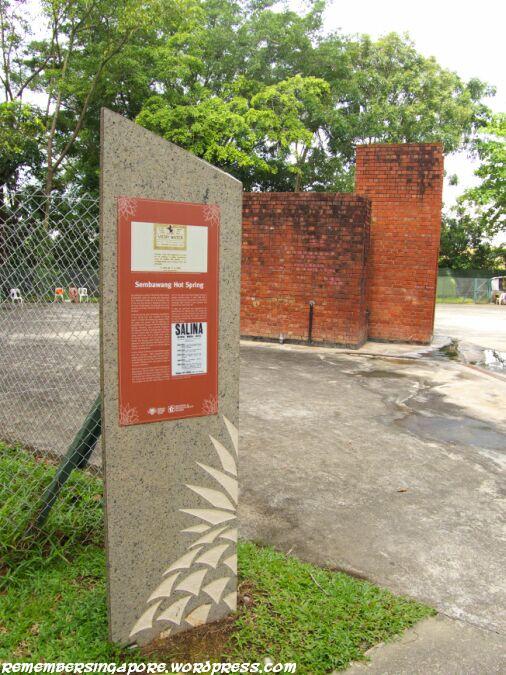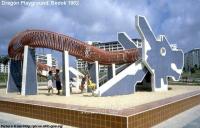The only natural hot spring on mainland Singapore, it was reported that the spring was discovered by a Municipal ranger W.A.B. Goodall in late 1908. Chinese businessman Seah Eng Keong, the owner of this plot of land, saw business opportunities in the discovery and went ahead to set up the Singapore Natural Mineral Hot Springs Company (the name was later changed to Singapore Hot Springs Limited) after tests proved that the water was safe for consumption.

A factory was built near the hot spring in 1909 to bottle the water and sell it under the brand “Zombun”. Fraser and Neave Limited (F&N) took over the Singapore Hot Spring Limited in 1921 and marketed their new branding as “Zom” and “Vichy Water”.
The area and the factory were also advertised as a tourist spot and opened to the public under the name “Seletar Hot Springs”.

During the Japanese Occupation (1942-1945), the area was turned into a thermal bath heaven for the Japanese officers, but the facilities were destroyed by Allied Forces’ bombing in 1944.


After World War II, F&N regained possession of the hot spring but it was only in the 1960s when some facilities were repaired to allow large volume of water to flow freely once more.
In 1967, F&N announced that they were looking at possibilities to covert the area into a recreational complex consisting of spas and restaurants but somehow the plans never materialised.

The Singapore government acquired the land in 1985 for military use. Initially the hot spring had to give way to the expansion of the Sembawang Air Base but after appeals from the public, MINDEF agreed to conserve the small area and open it to the public.
Standpipes channeling the water were finally completed in 2002, allowing the public to gain access to the hot water. During weekends, the area was crowded due to rumours that the hot spring was able to treat several skin diseases as well as rheumatism and arthritis.
However, its popularity has declined rapidly in recent years.

Visitors to the hot spring can freely use the buckets to contain the water, where there are no charges imposed. The area, which is about 100m from the main road of Gambas Avenue, is opened from 7am to 7pm.

Visitors can also catch a glimpse of the original well inside the small red-bricked building.
Published: 20 March 2011








Hi,
Please can you tell me whether the hot springs is still open to public? Are we still able to touch the hot spring water? Thanks!
Yes, it’s open to public from 7am to 7pm daily. You can collect the hot spring water in the buckets provided.
An enthusiastic reader Richard Hale provided these rare valuable photos of how the Sembawang Hot Spring looked like way back in the late 1940s 🙂
(Photo Credit: Richard Hale)
It was a childhood pastime to go to the hotspring and have fun^^, my dad usually bring my sisters and I whenever he had the chance,,, the sad thing is that I have moved out of sembawang and when I told my friends that a hotspring does exist in singapore,,, none believed me T__T
What is the,address ?
It’s located a little more than 100m from the junction of Gambas Avenue and Sembawang Road
(Photo Credit: Google Maps)
Wow memories…. remember going there during a school excursion. we could boil eggs in the drains and it came out hardboiled!
It was at Jalan Mata Ayer ( Spring water ). This area occupied by Boyanese residents. Enjoying visiting my friends during Hari Raya. Few years ago, I used to cycle along the main road. Wah! a bathtub is ready to use.
reason why the water is hot usually is b’cos of volcanic activities, but as we know there’s no volcano here, so how come can splash out hot spring water ??? maybe got underground machines running nearby, LOL shd be renamed Hot Underground Machine Water, HUMW, LOL
There is another hot spring in Singapore, not on the mainland but on the restricted island of Pulau Tekong.
http://the4moose.blogspot.sg/2010/05/pulau-tekong-unum-and-second-hot-spring.html
thanks for the link! the hot spring is still there and you could see bubbling and smoke at the shallow ponds around it.
A photo of Pulau Tekong hot spring in the 1980s
(Source: http://www.youtube.com/watch?v=XVfEKMFvUD8)
my uncle used to frequent this place until he chance upon ‘pontianak’ near there. i am for one can’t really say i believe or a non-believer in such matters because i have no personal encounters…but i know better not to dis-respect them, my uncle, the ‘spirits’ and anything related in-between.
There is a spirit there according to some people
How about parking? Can the car go right in? Could anyone advise please? Thanks
no you cant drive in. you have to park nearby and walk over.
Hi!
I would like to visit this Sembawang Hot Spring. Is this place still accessible? My aunt told me that this place got closed down.
because they build the camp and it was closed down .Warning they will do shooting in the camp.
this is nearby my old kampung. Am very happy that they decide to save it and open to public! Thanks for the informative blog!
Where is the nearest place to park vehicle?
Well, you have to park at the nearby HDB and walk over. about a 200-300m walk. definitely no way you can park along the busy roads
Hi
Is it still open to public
If yes ,is it open everyday cos so far I not yet see before….
Eye on Sembawang: Flourishing in the far north
8 April 2016
Situated at the northernmost tip of the North Region of Singapore, Sembawang is one of the most historically significant areas in Singapore, having played a pivotal role as a British naval base and airbase during the Japanese Occupation. Today, however, it is a mostly residential suburban town with its own waterways, park, MRT station and schools.
Not bad for a place once partially burnt and wrecked during the second World War.
A military history
In the early 1900s, Sembawang was best known for being the site of the Nee Soon Rubber Estate, with vegetable farms and Chinese graveyards in the area. That changed in 1928, when decade-long construction on a major British major naval base began. The presence of the Royal Navy’s Singapore Naval Base (also called HMS Sembawang) and RAF Sembawang (completed in 1940) made Sembawang a prominent military base.
During the Battle of Singapore in February 1942, both bases were torched and destroyed by retreating British forces in order to prevent the Imperial Japanese Army from using them. Later on, in post-war 1945, the British regained control of both bases.
Along with the three other Royal Air Force bases in Singapore — RAF Changi, RAF Seletar and RAF Tengah — RAF Sembawang and HMS Sembawang and helped strengthen British military power in the country during the Malayan Emergency (1948 to 1960), the 1962 Brunei Revolt, and the Indonesia-Malaysia confrontation (1962 to 1966).
In the early 1960s, HMS Sembawang was used to accommodate the US Navy, in support of American action in the Vietnam War. The Singapore government then took over HMS Sembawang, and three years before the British withdrew from Singapore, converted it into a dockyard, better known today as SembCorp.
The force is still strong
While Singapore has not seen war for over 70 years, Sembawang has retained significant elements of its military past.
To this day, the British maintains a small logistics base at Sembawang wharf to control foreign military activities such as resupplying, refuelling and repairing Australian, British and New Zealand navy ships, as well as the navy ships of other Commonwealth countries under the Five Power Defence Arrangements (FPDA).
American air and naval forces also use the base facilities in Sembawang, thanks to a 1990 agreement between Singapore and the US. The Task Force 73 / Commander, Logistics Group Western Pacific (COMLOG WESTPAC) command has had its headquarters in Sembawang for the past 24 years, providing logistic support for the US 7th Fleet’s Pacific and Southeast Asia operations.
Several roads in Sembawang were named after Royal Navy admirals, cities, dockyards and warships, such as Canberra Road, Falkland Road and Wellington Road.
Suburban life
Though parts of its history are still prominent in the estate, Sembawang has largely grown to resemble most other suburban areas in Singapore. It has its own interchange and MRT station, as well as two malls, Sun Plaza and Sembawang Shopping Centre.
Schools in the estate include Wellington Primary School, the Canberra Primary and Secondary schools, and the Sembawang Primary and Secondary schools. A mix of HDB flats and private residential developments make up the housing in Sembawang.
https://sg.news.yahoo.com/eye-sembawang-flourishing-far-north-003056380–sector.html
Sembawang Hot Spring: MINDEF prepared to return land to SLA
23 Apr 2016
With the potential redevelopment of Sembawang Hot Spring into a national park currently being explored, the Ministry of Defence (MINDEF) has said on Saturday (Apr 23) that it is prepared to return the land occupied by the hot spring to the Singapore Land Authority.
Senior Minister of State for Defence Ong Ye Kung made the announcement at a People’s Association event on Saturday. At the event, Mr Ong said that the return of the land will not impact MINDEF and the Singapore Armed Forces’ operational requirements.
He also said MINDEF hopes a public agency such as the National Parks Board (NParks) can take over to improve and maintain the place, while putting in amenities such as toilets and adding more greenery. Mr Ong added that putting the place under a public agency means the land need not be tendered out to the highest bidder and become commercialised.
Earlier on Apr 16, the NParks senior director of Parks Development Kartini Omar confirmed the statutory board was working with the Urban Redevelopment, Singapore Land Authority and MINDEF on “the feasibility of using the area as a park”.
This came after Sembawang MP Lim Wee Kiak suggested in Parliament on Apr 12 that the hot spring – one of only two such natural sources in Singapore, with the other located offshore on Pulau Tekong – could be converted into a park and a popular attraction for Singaporeans.
Despite it being on MINDEF land, the Sembawang Hot Spring has been demarcated to allow public access since 2002. It is currently open to the public daily from 7am to 7pm, and some visitors believe water from the hot spring has healing properties.
http://www.channelnewsasia.com/news/singapore/sembawang-hot-spring/2724674.html
Coming Sembawang Hot Spring redevelopment draws mixed response
23 April 2017
Channel NewsAsia
For Aster Lee, going to the Sembawang Hot Spring was relief of more than one kind.
Ms Lee made her first visit to the hot spring along Gambas Avenue in April together with a group of brisk walkers. It was a place that she had been keen to visit for quite a while, she said. The 62-year-old retiree said she had also been having knee aches since spraining it last December, but felt some of the pain ease after soaking her legs in the hot water.
At the hot spring, water continuously flows out from the taps, providing visitors with an ample supply of hot water for various uses. When Channel NewsAsia visited the site in April, Ms Lee’s brisk walking group was boiling a basket of eggs in a pail of water. People were also spotted using the water to do their laundry.
“It was a really good experience. I enjoyed the hot spring water,” Ms Lee said.
Come end-2018, trips to this northern part of Singapore might be a tad different The National Parks Board (NParks) announced that the Sembawang Hot Spring area will soon be turned into a one-hectare park. Development of the park will start at the end of this year and is expected to be completed a year later.
Not that it could not do with a little sprucing up.
“At first, the place looked a little unsightly,” Ms Lee said, adding that she hopes more drainage facilities, toilets and trash bins will be installed during the redevelopment as this could help keep some of the mosquitoes and ants at bay. A drink stall could be also be set up.
Said Ms Lee: “The water can be used to make hard-boiled eggs, (while we enjoy) a kaya toast”.
Another member of her group agreed and gave some creative suggestions of his own.
“They could build a drain, just for your feet to soak in (as you) sit along an embankment,” 57-year-old Yeow Kok Hoong said. Others Channel NewsAsia spoke to, however, wished the site could remain in its current state.
Mr Teo Lye Hock, 67, another member of the brisk walking group, hopes the place remains free of charge after the revamp, calling it a “poor man’s spa”.
Another visitor, 59-year-old Mdm Pan Hiew Lian said in Mandarin: “I’ve already been coming here for more than 20 years. I don’t want it to be redeveloped because I think it brings a sense of nostalgia. Redevelopment might make it better, but it’ll lose its charm.”
Mdm Pan added that she used to visit the hot spring once a week when she was living close by and though she lives at Bukit Gombak with her husband now, they still visit it twice a month. Ms Lee and Mr Yeow also said that despite looking forward to the upgrades, the site should still keep its “rustic setting”.
CONCERNS OVER ENVIRONMENT, HERITAGE
Dr Grahame John Henderson Oliver, a senior lecturer at the Nanyang Technological University’s Asian School of the Environment, said that the redevelopment is timely as the area is currently very bare, but that feedback should be gathered among residents first.
“I think if you’re going to do any development in Singapore now, you do an environment impact assessment report and publish it.”
“People can review that and presumably there’ll be townhall type meetings where people with different vested interests – the local people, the development people – can all discuss and reach an agreement on how it could be,” he said.
However, one historian said modifying the hot spring’s present form could also mean losing a part of Singapore’s heritage. Mr Alex Tan Tiong Hee, the honorary secretary of the Singapore Heritage Society, said the hot spring is one of the few remaining places of interest outside of the city region that serves to highlight Singapore’s heritage.
“It’s something that doesn’t just cater to the folks living around Yishun or Sembawang, (but it’s also a place to show) tourists, our friends, that outside the urban areas we still have landmarks,” he said.
Mr Tan added that landmarks such as the hot spring help create, among residents, a sense of belonging to their neighbourhood. Without it, that sense of attachment is reduced.
NParks said that it will appoint a team of consultants to help with the design and implementation of the park. The consultants will also have to give a “comprehensive report on the hydrogeological study of the site”.
HOW THE HOT SPRING WAS FORMED
According to Dr Olivier, the hot spring’s formation is linked to Bukit Timah Hill. At 165 metres, the hill is the highest point in Singapore and when rain falls, the rainwater seeps through the granite within the hill.
The rainwater then sinks to about 4.8 kilometres underground, where it gets heated up by the surrounding rocks and mantle to about 160 degrees Celsius and 190 degrees Celsius, he explained.
As more rain falls, the water underground is pushed out through the faults and cracks that connect the ground under Bukit Timah Hill and the Sembawang Hot Spring, he said. The water then cools to 70 degrees Celsius as it reaches the surface.
http://www.channelnewsasia.com/news/singapore/coming-sembawang-hot-spring-redevelopment-draws-mixed-response-8785158
Sembawang Hot Spring will be closed for development from today until end September 2019.
Please do a piece on the abandoned bungalow in Sembawang and also the sembawang bomb shelter in the same area 🙂
Sembawang Hot Spring’s long-awaited and much-anticipated rejuvenation: